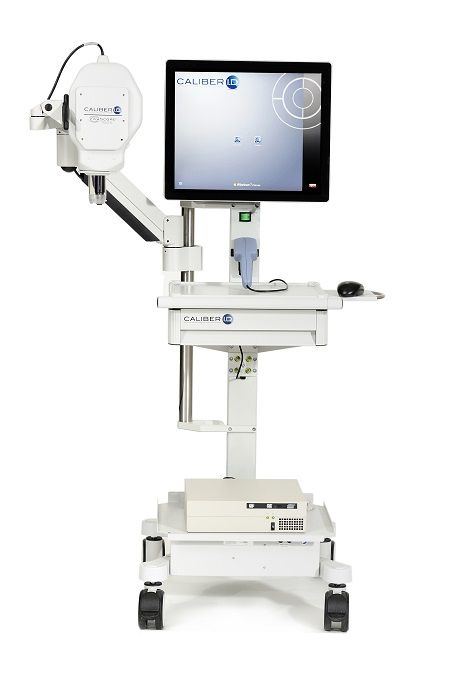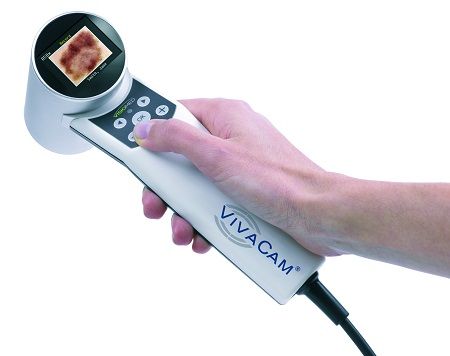More than 2 million people in the U.S. each year are diagnosed with some form of skin cancer. By conservative estimate, perhaps three times that number of people are suspected of having some form of skin cancer based on a clinical examination.
The next step is to undergo a skin biopsy to confirm or rule out cancer.
The Traditional Skin Biopsy
There are a number of types of skin biopsy. All of them – shave biopsy, punch biopsy, excisional biopsy, etc. – require the removal of some amount of the flesh, usually with a scalpel. The suspect site is numbed with an anesthetic injected by needle. Following excision of a section, a few stitches may be necessary to close the wound. Patients can expect a lasting scar at the incision site.
The procedure is generally safe. Bleeding can occur, and the biopsied site can become infected. Occasionally the patient is allergic to the anesthetic or topical antibiotic applied afterwards.
Normal protocol now requires the patient to wait: for the biopsy to be processed properly, for it to be sent to a qualified pathologist, for the pathologist to examine it under a microscope and to write a report.
In time – days or weeks – results reach the patient's physician's office, where they sit until the doctor reads them and contacts the patient (we sometimes believe our doctor calls us the moment they receive our pathology report – such delusions are on us). Eventually results are conveyed to the patient.
For millions of these people – a majority – the procedure concludes when they learn that, whatever else they might have, they don’t have skin cancer. What they have is a scar and a close call.
There ought to be a better, faster, less invasive and equally effective way for patients to learn whether that mole is cancerous. And indeed there is.
The No-Cut Biopsy
In a growing number of medical centers and clinics around the world, there is a better way to biopsy the skin. It's a method that, for the millions of people who don't have skin cancer, allows them to avoid going under the knife.
Caliber Imaging Diagnostics of Rochester, N.Y., has developed the VivaScope, technology that CEO L. Michael Hone refers to as an optical biopsy.

"The VivaScope is a confocal microscope that uses a laser as a light source," he says. "The laser takes advantage of the natural luminescence of the skin and allows us to produce digital images, in real time, down to the individual cell level. We’re able to create images comparable to what a pathologist sees in a traditional histopathology."
These images can be interpreted then and there, if the dermatologist is also a dermatopathologist. If the doctor does not have pathology training, he or she can transmit the images to a qualified pathologist instantly and, in many cases, hear back on the diagnosis in a matter of minutes or hours.

"By providing live imaging of the cell structure, we are giving doctors the tools to make a more informed clinical decision," says Hone. Feedback from doctors already using the VivaScope suggests that the device can rule out cancer without the need for any additional biopsy in two out of three patients.
This technology was cleared by the U.S. Food and Drug Administration in 2008, and several clinical trials testify to the accuracy of the device in providing a digital look at what’s happening at the cellular level for the most common forms of skin cancer, basal cell carcinoma and squamos cell carcinoma, as well as the more deadly form, melanoma.

The value here won’t be lost on the parents of very young children whose pediatrician notices a suspect mole or other skin abnormality. Prior to the optical biopsy, an infant would have to endure the same invasive biopsy as anyone else.
Furthermore, you never know where these lesions may develop, on what part of the body: a part that can be concealed with clothing, or on the face, hand, neck or arm? There is no great vanity in not wanting an otherwise unnecessary scar to be created on your forehead because your doctor wanted to biopsy a small mole, only to find out it was benign.
The VivaScope is also not limited to the skin. "We're able to go into the operating theater and provide in vivo images at the cellular level that, in other cases, would require the removal of a sample of tissue which would then need to be sent to the lab while the patient is still under."
This, says Hone, speaks to the device's broader applications. As is often the case in medical advances, originally the VivaScope was developed for use by companies that created things like skin lotions, to allow researchers to see the efficacy of the tested product.
Before, in order to determine efficacy, test participants would have to be cut. Today, the VivaScope can be found in a small but growing number of medical centers, such as Brigham and Women’s Hospital and Massachusetts General Hospital. Currently, optical biopsy is not covered by any insurance plans and is an out-of-pocket expense running around $150. Caliber is working to change that, but in the meantime that's a reasonable price to pay for technology as advanced and as patient-friendly as this.
"There are other confocal microscopes on the market," says Hone, "but they're vastly more expensive and they examine skin samples ex vivo."
And there's the rub: Caliber's technology allows in vivo imaging. The difference between in vivo (within the living body) and ex vivo (outside the body) is essentially the difference between what a scalpel can do to the flesh.
To that end, Caliber ID's optical biopsy is redefining the skin biopsy. After all, if you could get a pathology report regarding skin cancer that is as good as a traditional biopsy – but without the need to be cut, stitched and scarred – wouldn't you take it?







